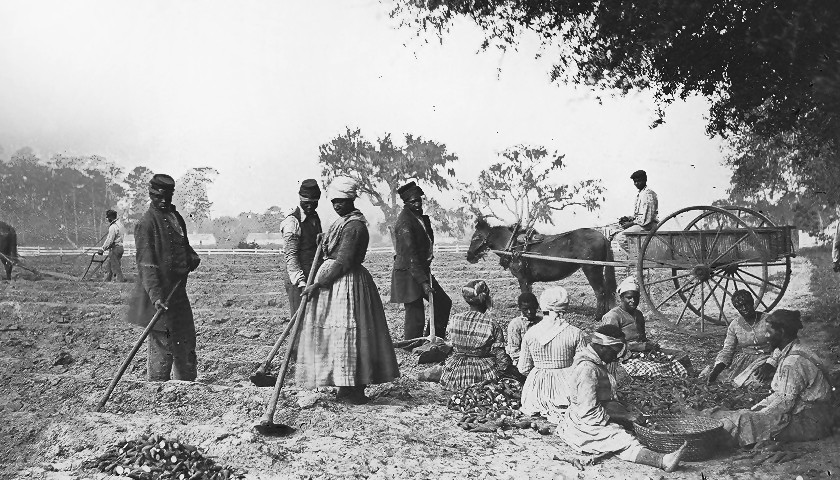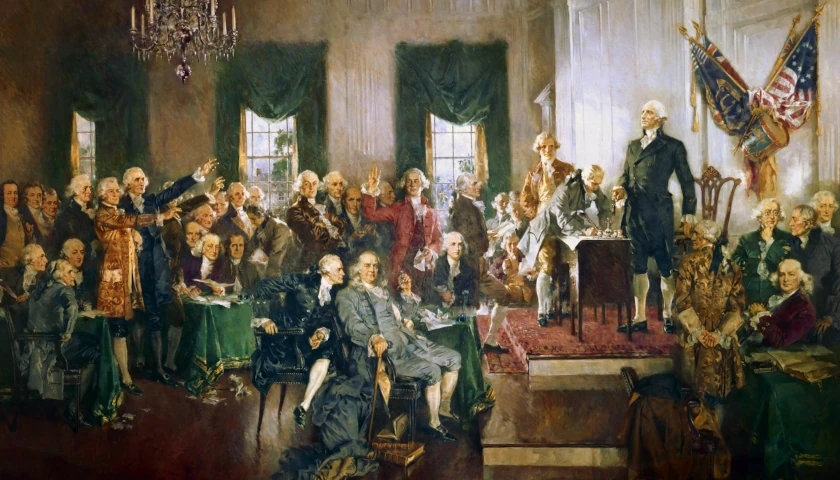By Vincent Geloso
In the past few decades, a new subfield of history has emerged: the history of capitalism. The subfield is widely popular in the media as a result of hugely influential books such as those of Sven Beckert and Edward Baptist. These two particular authors tie the “peculiar institution” of slavery in American history to capitalism. Many media pundits, as witnessed by recent articles in the New York Times and Vox, jumped on the works of these authors to claim that slavery was “the building block of the American economy” and it made America richer.
To make this case, these scholars invoke three facts. First, the southern states enjoyed relatively faster growth than the free northern states. Second, slavery was immensely profitable to slaveholders. Third, the rapid increases in slave productivity – as measured by cotton picked per slave – meant that cotton output exploded. From this, a causal claim is made: slavery made America rich because increasing slave productivity increased profits and fastened economic growth.
With the exception of whether or not the South grew faster than the North, which is debatable to some degree, there is little to dispute on a factual basis. However, it is impossible to infer that America was made richer from these facts. In fact, when interpreted with the light of economic theory, the second and third facts actually suggest that the reverse is true: America was made poorer because of slavery.
Economic growth in the United States pre-1860
One of the most-cited pieces of evidence is that south enjoyed rapid economic growth before emancipation. The logic is that if the south grew faster than the north, slavery – which was so important to the southern economy – must have been a contributing factor. Most of the evidence for this rests on the works of Robert Gallman and Richard Easterlin who constructed income estimates for the period after 1840. In their pioneering work, Time on the Cross, Robert Fogel and Stanley Engerman used this data to show that, between 1840 and 1860, the south grew faster than the north: 1.7% per annum versus 1.3%.
However, this is a claim with shaky foundations. First, the benchmark year of 1860 overstates the level of income per capita. The cotton crop that year was higher than normal. The effect from this is mild, but it is enough to shave off a few decimal points to the initial estimates of growth for the southern states. Economic historian Gerald Gunderson also suggested that the census of 1840, which was used to estimate output in that year, was known to be one of the most poorly conducted in census history. This lead, in his opinion, to an inaccurate starting point that also contributes to overstating southern growth between 1840 and 1860.
Secondly, economic historian Jeffrey Hummel identified a series of weak points in the national account estimates of Gallman and Easterlin. These weak points relate to how the South was defined (some slave states were wrongly allocated to the North), how certain new states like Texas had overstated incomes, how the income from service sectors was underestimated in some regions and overestimated in others, the value of subsistence goods given to slaves and the price deflators used to estimate output. Hummel proposed revisions to adjust for some of the problems he exposed. The revisions reduced the gap in growth rates between the region.
Third, taken separately, none of the different regions of the South experienced faster growth than the different regions of the North: the Northeast and North Central enjoyed growth rates of per capita income equal to 1.7% and 1.6% between 1840 and 1860 while the South Atlantic, East South Central and West South Central regions enjoyed growth rates of 1.2%, 1.3% and 1.0% during the same period. This apparent anomaly is explained by internal migration: Southerners moved from where incomes below average to where they were above average. These movements in population, when aggregated for the two while regions, create the impression of fast growth in the South. However, it is worth pointing out that the higher-income states of the South grew more slowly than the higher-income states of the North.
Lastly, if we extend the period considered, the picture that emerges is quite different. Peter Lindert and Jeffrey Williamson reconstructed income statistics between 1675 and 1860 in order the different regions of the United States with Great Britain. They found that, between 1675 and 1774, incomes per capita in the southern states fell by roughly 15% while the middle colonies stagnated and New England enjoyed a mild increase.
Thereafter, the southern economy grew, but at a slower pace than the North: economic growth stood at 1.94% per annum in New England between 1800 and 1860 while it stood at 1.66% and 0.90% in the Mid-Atlantic and South Atlantic states.
Similarly, Robert Margo’s work on wages between 1820 and 1860 showed that wages for common labor in the Northeast increased faster than in the South Atlantic and South-Central regions (although wages in the Midwest did not increase as impressively). Adding to this the wealth estimates of scholars like Alice Hanson Jones, we find that the South actually lost ground relative to the North from the beginning of the colonial era. It did grow, but the Northern states performed better.
The sum of these points suggest that we ought to be careful about making inferences from this “fact.” However, even if that point was a certain one, it would not say much about wellbeing.
Productivity and profitability: do not confuse output with utility
The other two facts – that slavery was immensely profitable and that slave productivity increased – are not debated. Scholars accept them as true. In fact, of all the claims contained in Time on the Cross, these are the two that survived the test of time. However, one cannot infer that slavery made America richer from them. In fact, these two facts point in the opposite direction.
Under slavery, slaves received as “wages” (for lack of a better term) only the subsistence items that their owners allowed them to consume. That is a (poor) form of compensation. As a counterfactual, imagine a world where slaves were free and ask yourself this question: what quantity of labor would have been provided for the utility derived from these subsistence items?
It is hard to arrive at a convincing number. However, it is clear that whatever the quantity of labor provided when induced solely by compensation, it would have been less than the quantity of labor coerced by slaveowners. Consider the flipside of that counterfactual market. If slaveowners had to convince free workers to work for them, they could only have induced them to do so via higher wages. And this is not only a counterfactual that includes quantity of work, it includes also the quality of work. In free situations, workers in unpleasant jobs tend to be offered higher wages to compensate for the inconvenience. This is why backbreaking work, all else being equal, tends to be better remunerated than physically easy work.
As long as there was a difference between the value of what a slave produced and the value of subsistence, there was a transfer from slaves to slaveowners. This is why economic historians like Gavin Wright writes that “slave-based commerce remained central (…) not because slave plantations were superior as a method of organizing production, but because slaves could be put to work on sugar plantations that could not have attracted free labor on economically viable terms”.
However, here comes the rub: this increased physical outputs.
In economics, dollar signs are often used to “mimic” utility. This is because the models that teach students about utility implicitly embed an assumption about personal freedom and agency. If people are free to take prices as they are, the prices can be translated into information about utility in a very straightforward manner. This is why economists frequently emphasize how well statistics about Gross Domestic Product (GDP), which rely on market prices to be calculated, speak to human wellbeing. The quantity produced and measured are reflective of utility. As such, the changes in one will be reflected by changes in the same direction in the other.
In the presence of coercion, this is not necessarily the case. All the statements that economics students are taught remain true. However, it is no longer possible to infer utility as easily from reported prices. If one is coerced into working more than he would have at the compensation offered, he will increase economic output. More labor, more output. However, at that level of compensation, he would have preferred to work less and take more leisure time. This why some economists like Yoram Barzel and Stefano Fenoaltea consider slavery as a tax on leisure rather than a tax on labor. As that person would have derived more utility from leisure than from work at the offered compensation, the coercion changes output in a manner that divorces it from the change in utility (greater output, lower utility).
In such a divorce, the coercion of a greater labor supply creates a deadweight loss. In other words, people would have gained more utility without the coercion. This deadweight loss can be approximated and be given a monetary value that does speak to utility. The amplitude of that loss is the extent to which Americans were made poorer.
This deadweight loss serves to resolve two conundrums. The first is that it explains the institution’s profitability and viability. Slaveowners used the inputs they had as efficiently as possible and extracted important profits. However, this says little about living standards as the level of these profits reflects the extent of the deadweight loss. Thus, the institution may have increased output in ways that made slaveholders rich– as it did – but it made Americans worse off.
The second resolved conundrum relates to the finding of Fogel and Engerman that southern slave farms were more productive than free northern farms and slave productivity increased importantly during the Antebellum period. Fogel and Engerman argued initially in Time on the Cross and later in Without Consent or Contract that this was a result of the economies of scale involved in plantation farming: large plantations were more efficient than small plantations. That finding in their work was hotly debated on methodological grounds.
However, even if one remains agnostic on the methodological choices, that finding is unsurprising. The gang labor system under slavery, which generated the economies of scale described by Fogel and Engerman, was adopted because it could best extract output from coerced workers. It does not deny the existence of a deadweight loss – it confirms it!
That resolution is only reinforced when one stops being agnostic with regards to some of the methodological choices made by Fogel and Engerman. For example, more recent evidence discussed by Jeffrey Hummel suggests that hours worked by slaves were greater (even at the low bound) than by free workers in the North. As Fogel and Engerman had argued “greater intensity of labor per hour, rather than more hours of labor per day” explained the productivity advantage, finding that both intensity and quantity were higher only piles it on.
The Deadweight Loss of Slavery
What was the deadweight loss of slavery? Using data on estimates of earnings of free workers, hire rates for slaves (which are better at approximating the marginal value to slaveowners of an extra slave) and subsistence consumption taken from the core texts on the economics of American slavery, Jeffrey Hummel estimated that deadweight loss. He placed it at between $52 and $190 million in 1860 with the smaller amount representing 5 percent of total oncome in the region. In other words, the loss in utility of forcing slaves to provide more labor than they otherwise would have had a value of between $52 and $190 million.
But that is not the whole sum of deadweight losses. In the southern states, the enforcement of slavery was not fully undertaken by slaveowners. The states mandated slave patrol duty for free whites. This relieved slaveowners of the costs of enforcement (while they kept the rewards from coercion) which were spread over a large population. The mandatory duty was a tax in the form of labor in kind. In some states, there were actually taxes to finance the patrols. Hummel estimated the sum of enforcement costs brought his estimates to between $64 and $210 million. This represents at most a fifth of the southern economy in terms of inefficiency. This remains a conservative estimate as there was also a deadweight loss from forcibly reallocating non-slave labor towards patrolling which is hard to measure.
This addition is useful as it shows that the deadweight loss was not contained to slaves. It extended to poor non-slaveholding whites. Scholars, such as Keri Leigh Merritt in Masterless Men, have begun to highlight how the preservation of slavery necessitated policies that kept non-slaveholding whites poor, landless and illiterate. While slaves bore the brunt of the harm done, it was not contained to them. This explains why Hinton Rowan Helper’s Impending Crisis was so popular (even in the South) even though it was racist and anti-slavery: it catered to another impoverished group.
It is clear that one cannot infer that America was made richer from the often-used facts about growth and slavery. It is even clearer that America was made poorer by slavery. Slavery leaves a nasty legacy. Its preservation required the use of racist ideological constructs to justify it. These constructs persist today and, since Emancipation, meant that incredible violence was directed towards African-Americans. It bred a class of rent-seekers who continued their rent-extraction efforts in the form of segregation laws and public goods funded by all but whose use was restricted to whites. To these items in the shadow of slavery, we must also add a poorer America.
– – –
Vincent Geloso is a visiting assistant professor of economics at Bates College. He obtained a PhD in Economic History from the London School of Economics.






You’re right. The U.S. as a whole did not prosper as a result of slavery. Only a few rich white slaveholders in the Southeast as well as a few northern merchants and stock brokers on Wall Street got rich from slavery. Indeed, the wealthiest people prior to 1860 were plantation owners chiefly along the Mississippi Delta.
For everybody else, slavery was an impeiìdiment to economic growth. How else to explain why per capita income in the Southeast as well as chief social indicators in the Southeast started to fall behind the rest of the nation after 1840? The bulk of immigration from Europe during mid-century would settle between the Middle Atlantic, New England, the Great Lakes, and the Pacific West. The Southeast’s cities would fall behind in growth. Education levels for whites as well as blacks would fall in that region. The slavery system had a steak in holding the South backward. This procedure helped enabled a few slaveholders to have more political power and seniority in the U.S. before the Civil War. No wonder the rest of the U.S. viewed slavery as an economic threat to free white male labor! It even dawned on some common Southeastern whites who could never hope to afford the same number of slaves and top quality land that the small elite number of slave holders had would eventually play a major role in causing the Civil War and turning that war eventually into a crusade against slavery to save the Union.